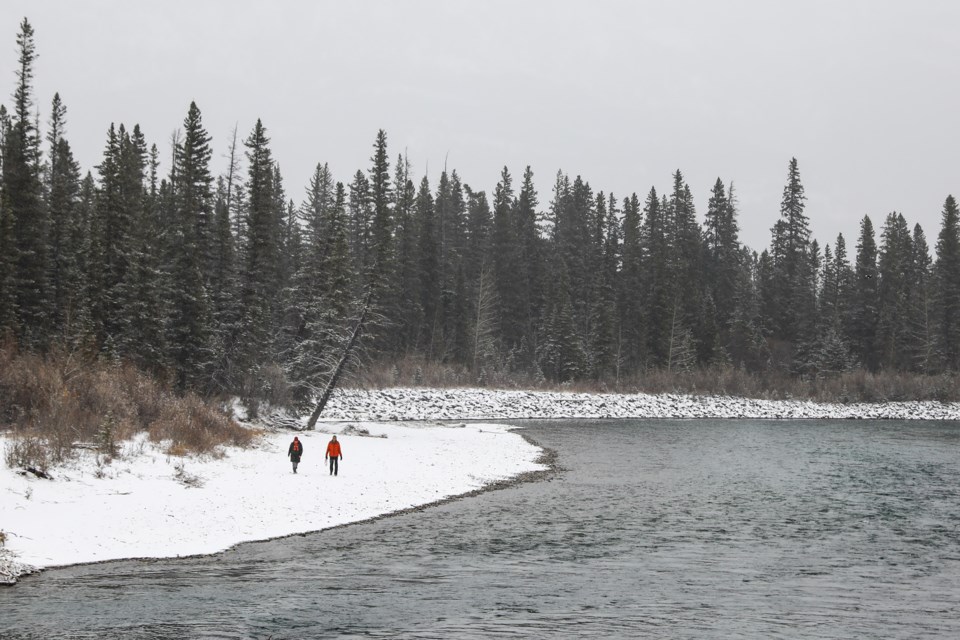The Town of Cochrane’s existing license to withdraw water from the Bow River is set to reach its maximum level in as little as four years, throwing into question how current rates of growth may be sustained in the near future.
The province put a stop to any applications for new licenses in the South Saskatchewan River Basin (which includes the Bow River) in 2006.
How crucial this situation could become depends on the perspectives of various stakeholders – is the glass half full or half empty?
At a council meeting March 6, Town administration presented a report estimating that at current growth rates, water license limits (allowing for a population of 40,000 people) will be reached in four to five years (but closer to four).
Applying the Town’s 4.4 per cent growth rate assumption to the current population of 33,453, the population would be precariously close to the 40,000 limit in four years.
The Town says not to worry. They have submitted an application with Alberta Environment, seeking a solution.
“Council and administration are committed to ensuring that those who choose to make Cochrane home will be supported with all of the required services to support a strong, resilient and robust community – including adequate water supply now and into the future,“ Town staff said in an email.
A water licence is required for any individuals wanting to use or divert water in Alberta. From businesses to individual use, the regulations apply to ground or surface water.
Since August 2006, the moratorium on the issuance of new licences has created Canada’s first market-based system to transfer (trade) water.
The challenge in this scenario is finding existing license holders willing to transfer their water rights.
Alberta’s existing water transfer system currently allows for the re-distribution (trading) of water licences between different water users, under certain conditions. The current system has several public policy protections: a public review of every water transfer, each transfer is considered for its hydrological and third-party impacts, and the province has the opportunity to hold back 10 per cent of the allocation for environmental instream purposes.
“An unintended consequence of this practice, however, was that most municipalities did not apply for water licences that would be large enough to accommodate their long-term growth. Therefore, when the SSRB was closed to new licences, many communities found themselves with very little licensed capacity for their future water needs, especially considering the rapid population growth in the Calgary area in the late 1990s,” stated a 2010 report in Canadian Water Resources Journal.
The Alberta WaterPortal Society is a charitable organization that provides research, community engagement, and educational activities to improve the public’s understanding of the importance of water in Alberta.
The WaterPortal website states, “Because the Bow Basin is closed to new allocations, if these municipalities wish to grow beyond the limits of their current water licence capacity, they will need to reduce water consumption beyond the 30 per cent target used in this analysis, acquire additional water supplies through licence transfers, purchase raw or treated water from a regional system or external supplier, or use alternate water supplies such as groundwater or reclaimed wastewater.“
Andre Asselin, executive director of the not-for-profit Alberta Water Council, said using reclaimed wastewater may be a tough sell to some, but he pointed to a Calgary brewery that uses it to make beer.
He added that the Cochrane situation is illustrative of what’s to come in securing water for other fast-growing communities.
“It’s a reflection of the challenges we’re facing going forward – extended population growth requires water,” Asselin said
“It might be more of a paper water issue, where it’s a licensing thing, but you’ve got to plan for the worst – that’s why you may be running up against limitations on growth in certain communities.”
So it’s not about how much water is being drawn down; it’s about who holds the license – ‘paper water.’
On the glass-half-full side is Kim Sturgess, CEO of WaterSmart Solutions, an Alberta-based water management advisory organization that is in contact with the Town.
“I’d say Cochrane’s on a very positive path, identifying pretty innovative opportunities to look at transfers that meet the needs of all the parties,” she said.
One of the founding principles of the entire process, she noted, is to ensure there will be no detrimental effects to anyone downstream in the watershed.
The Bow River Basin is highly allocated; approximately 46 per cent of the average annual natural river flows are either diverted or consumed.
Irrigation is the largest user of water in the basin, accounting for 72 per cent of allocations. Municipal water use represents only 20 per cent, with agricultural, industrial, and other uses representing one per cent, one per cent, and six per cent, respectively.
Prior to 2006, applying for and receiving new water licenses was fairly straightforward – post moratorium, not so much.
Just ask Rocky View County (RVC) officials, who got caught up in a controversy in 2007 when the CrossIron Mills shopping mall development was being approved on the assumption water would not be an issue.
They expected to access water for the development from the Bow River, but then the province put an end to new water requests, forcing the County to apply for a transfer.
The municipality then targeted the Red Deer River, since the moratorium does not cover that watershed. But that request sparked opposition from municipal and provincial politicians in Red Deer which killed the idea.
RVC finally settled on a transfer proposal with the Western Irrigation District (WID), one of 13 non-profit organizations set up to deliver water to southern Alberta, which included a promise of $15 million to the WID to convert 50-kilometres of a leaky canal into a pipeline, reducing the amount of water lost to evaporation and saving more water than would be transferred to Rocky View for the new development.
WID members approved the proposal by 57 per cent in a plebiscite.




